I’ve just finished up my time in Peru, which revolved around one major task: hiking the 4-day 3-night Inca Trail to Machu Picchu. Far and away the most physically challenging task I’ve undertaken, and also – unsurprisingly – truly amazing. Worth every penny and drop of sweat.
I got to Lima last Tuesday morning, and after spending the afternoon eating ceviche and using the internet, met up with my Inca Trail tour group. Like in the Galapagos, I’d booked a tour through G Adventures; although we’d eventually have 14 people in our group, only four of us had gotten to Lima in time for the 6pm briefing: myself, Adele from Melbourne, Sam from Florida, and Chris from Perth. A process like this makes fast friends out of any group of strangers, and we wasted no time doing so – we all went out for dinner and dessert immediately after the briefing. Highlights of the evening: my first taste of chicha morada, a sweet purple corn drink, and coming across a big gathering in the street which, after some inquiring, turned out to be a funeral procession (we’d guessed it was a wedding… oops).
More of our group had turned up by the next morning. Page, Emmy, Kieran, and Dylan all came together from Melbourne, a brother-sister pair who had each brought along a friend. The guys, Kieran and Dylan, were only 19, and rather openly admitted that they were stupid. Dylan especially. He really was stupid. But despite being an idiot punk, and the lot of them generally being classic young boozy Aussies, they were all very friendly and kind.
Jamie from Washington D.C. – along with the aforementioned Chris and Adele – would turn out to be some of my closest companions on the hike. Jeremy, from Toronto, would be my tent-mate for the three nights of camping on the trail. Jean and Ronan were our only couple, literally just married days earlier, from Dublin. The remaining two – Anna from Malmo, Sweden, and Kate from Brisbane, met up with us that afternoon, once we’d flown to Cuzco.
Cuzco, the base point for our hike, sits at 3,400m (~11,200ft), nestled in a valley in the Andes. Although some of us had trouble with the altitude, everyone acclimated after a few days, and I managed to avoid any headaches or discomfort almost entirely. I’m sure that the 2-3 cups of coca tea per day helped with that. That first day in Cuzco, a Wednesday, was relatively uneventful: our tour guide, David, took us on a brief tour of the city, helped us find lunch and dinner, and gave us an overview of what would happen over the next few days. That night, after renting sleeping bags and equipment, we had the daunting task of consolidating our belongings into a 4kg parcel, which would be carried on the trek by porters. Each porter is only allowed to carry 6kg per-passenger; all of us rented the standard 2kg sleeping bag (hence our 4kg allowance), and skipped the extras, like mattress pads, which would have reduced our allowance for personal possessions even further. Unsurprisingly, I used almost every last gram. The rest of our belongings would have to wait at the hotel in Cuzco until the hike was over.
The next morning we set out early for the Sacred Valley, an area northwest of Cuzco (the old Inca capital city) that is littered with Incan ruins, temples, terraces, and villages. Our first stop was a small local village, where we all overpaid for souvenirs hand-made by the locals. Still very cool, though: we got to see the process of naturally cleaning and dying the llama and alpaca wool, and the hat I bought – made of baby alpaca – is divinely soft and served me well on the trek.
Our next stop was Pisac, where we took a ~1.5 hour hike down the mountain to the ruins of an Incan sun temple. The sun was the primary deity in Tawantinsuyu, the Incan empire, with almost every major site having some kind of sun-related place of worship. Pachamama (mother earth), along with water and the mummies of dead rulers, were also considerably revered.
After lunch at a rather touristy buffet stop – called Inkalicious – we arrived in Ollantaytambo, our stop for the evening and last launching point before the trek. We climbed up the terraces leading to the local sun temple, and admired the huge, perfectly-shaped monoliths that had once been part of its walls. As with all of the perfectly-shaped stones crafted by the Incas, these were sculpted by caring small holes, inserting wooden beams, and then saturating the beam with cold water until the swelled and fractured the rock. How they transported these monoliths from distant mountains, however, seems unimaginable.
That afternoon was our last opportunity to buy supplies, and I knew I needed to address the problem on my foot: in the Galapagos a week earlier, I’d mysteriously discovered a few small cuts on the top of my right foot, and one had gotten infected. Per Chris’ (a pharmacist’s) suggestion, I bought some antibiotics to help clear it up.
As it would turn out, however, I never took them. When I woke up the next morning my foot was noticeably better, but my gut had taken a turn for the worse: traveler’s diarrhea, in full force. And just hours before starting the hike. Lucky for me, Chris had brought half the pharmacy with him (I’d left a good chunk of my medical supplies back in Cuzco), and I immediately took an Immodium and started a different round of antibiotics. It all took hold just in time; although I was a bit weak that first day, my toilet troubles were over almost as soon as they’d started.
The Inca Trail itself starts at around 2,600m, down in the Sacred Valley, and features three major mountain passes: Dead Woman’s Pass, the first and highest at 4,200m (~13,700ft); Runkuraqay pass at 3,900m; and a pass near the old city of Phuyupatamarca, at 3,700m. Machu Picchu, at the end of the journey, sits rather low by comparison at 2,400m. The first day of the hike, however, featured none of these passes; after a relatively easy five hours of hiking, we’d reached our first campsite near Wayllabamba, at 3,000m.
Sickness was an ever-present theme for the 14 of us on the trail; although I was starting to feel better, Chris had come down with similar troubles. Chris started vomiting only a couple hours into the hike, and after we stopped for lunch, seemed even weaker. I hung back with him and David for moral support. Per my suggestion (of course), David helped pass the time by teaching me how to say inappropriate phrases in Quechua, the native Incan language. For your future reference: “akasiki” means “shit ass.” I’m sure you were dying to know.
I’ll take a moment here to talk about the porters and our food. Truly amazing. Each of these guys is allowed to carry up to 25kg, and for the 14 of us passengers (not including David and our assistant guide, Edith), we had 22 porters. These guys are true Inca Trail wizards; they glide past us pathetic westerners, who are panting and heaving with only a few kilos on our backs. By the time we get to our lunch spot, they’ve already set up a tent, complete with table and chairs, and prepared a three course meal. By the time we get to our campsite, all our tents are set up, duffels correctly placed in each one, and the food tent is set up and ready with coca tea and popcorn. On top of that, the food they make is absurdly good – and, because of my dietary restrictions, they’d often make something separate just for me. An example of some of the food we had: for breakfast the first morning, we had quinoa porridge, tea, and pancakes. I could eat the porridge, and they made an omelet especially for me to replace the pancakes. Lunch and dinner always started with soup, often a traditional light Andean soup with quinoa and vegetables. The main course was always different and featured any number of things, from potatoes stuffed with tuna, to chicken kiev, pasta and rice, etc. One day, for dessert, they baked a cake to celebrate Sam’s birthday. All of this would appear out of the small kitchen tent, perched in the middle of nowhere along the Inca Trail, and compress back onto the porters’ backs every time we moved. Unbelievable.
Coming back to the trail narrative: that first night, after the first of three awesome dinners, our group started what would become our group tradition: playing the card game Shithead; this ultimately lent our group the unofficial name, “The Shitheads.” This also seemed appropriate, given the amount of shit-related sickness within the group. Poor Chris didn’t join us that evening, as he was busy dealing with the matter himself.
Day two of the hike was the most challenging, as we were warned; after a hearty breakfast at 6am, we started the often-grueling climb from our campsite, at 3,000m, to the top of Dead Woman’s Pass at 4,200m. We took two major stops along the way for snacks and/or bathrooms, one at 3,300m and one at 3,800m, which broke the process into three, roughly one-hour-long hiking periods. The final climb was especially challenging, with noticeable altitude effects. Even the porters couldn’t swoop past us as easily as before. I reached the top around 11am, and actually cried a little bit out of relief, exhaustion, and happiness – it’s the moment in the hike where you know you’ve suffered the worst of it, and that you’re very likely to make it all the way to the end. All that time spent on the Stairmaster at the gym had paid off :p!
Most of the group breezed through the last segment of the day, a 600m descent down to our lunch spot and campsite, but I struggled a bit more than expected; turns out that downhill isn’t my forte, and that my ankles aren’t as strong as most. So I did the old man shuffle down the mountain with my walking sticks, and got there about half an hour after most others.
Our campsite on that second day was exceptionally beautiful: from our tents perched on an old Incan terrace, we looked out on a cascade of mountains draped with clouds. This was also our highest campsite, at 3,600m, and the air was particularly cool and crisp. Since we’d finished our hiking for the day at lunch time, we spent the rest of the day lazing around, playing cards, and eating almost constantly. Not a bad way to wrap up the most difficult segment.
Day three started off challenging, but became considerably easier. It also marked the start of a series of Incan ruins, complete with their trademark immaculate mortar-free stonework. After a rather steep climb, our first stop was at the Runkuraqay ruins, which served as a resting stop for those on the way to Machu Picchu. After another steep segment, we reached our second-highest peak – Runkuraqay pass – where we stopped for a snack. At this point I managed to do just about the stupidest thing possible: while slicing open an orange with a knife, I sliced open my finger instead. Fail. The wound was a bit deep, but very clean, and I got it wrapped up quickly. Currently healing up just fine.
The rest of the day was relatively easy. We stopped for a walk around Sayaqmarka, a hilltop encampment that marks the separation of the highlands from the rainforest. The landscape did change dramatically from that point on, transforming from grassy, dry mountain faces to lush, wet forestry. The climb from that point on to the third and final pass, near Phuyupatamarca, was pretty easy. Jamie and I hung back with Adele, who had now fallen ill, along with a mysterious stray dog that showed up and protectively followed her for the rest of the day. We named him Red.
After lunch at the summit (which featured Sam’s birthday cake), we descended 1,000m down to our final campsite at Wiñaywayna. Along the way we had an amazing sighting: Jamie, Chris, and I, who walked separately from the others, came across a Spectacled Bear on the path. According to David, a sighting that close is exceptionally rare; it happens maybe 2 or 3 times per year, since the bears are very wary of humans and typically keep a good distance. It was brief, but undeniable: the bear leapt up onto the trail about 40 feet ahead of us, ran down the path a bit, and then disappeared into the forest. It all lasted maybe a second, and left the three of us slack-jawed. What a treat!
We reached Wiñaywayna around 5pm, after making a brief photo stop at Intipata. Dinner, one last (ultimate) game of Shithead, and then off to bed; the next and final morning would start at 3:30am. That night, deep in the rainforest, the rain poured down endlessly. We’d been relatively lucky with the weather so far, with only some rain during hiking hours (though more in the afternoon, once we’d finished for the day). That night and the following morning were the exception, however; I didn’t sleep too much, since the tent started to leak and the bottom of our sleeping bags slogged with water. The next morning, still pitch dark and now thoroughly wet, we had our quick breakfast and started off on the final leg of the trek.
Wiñaywayna campsite is strategically located for those who want to reach Machu Picchu as early as possible. It’s a short five minute walk from the technical end of the Inca Trail, at which point the group of us (along with the hundreds of others doing the trek) waited until 5:30am, when the Machu Picchu area opens. From there, however, it’s another 80 minutes to the Sun Gate, and yet another 40 from there to Machu Picchu. Although it was short by comparison, it ended up being one of the most unpleasant segments: the pace was aggressive, and it was still pissing down rain. Once we reached the Sun Gate, there was no view to be seen; though it’s normally the first glimpse you get of Machu Picchu, all we saw was a wall of white cloud. To top it off, on the final descent down to Machu Picchu, I slipped about a dozen times and fell over three of those times; during one of those falls, I damaged my camera such that several of the buttons no longer work. Thankfully it’s still able to turn on and take pictures, but that’s now about all it can do – no switching settings or looking at photos. After 72 hours on the trail, I’d arrived at Machu Picchu sopping wet and in a foul mood.
My attitude changed with the weather, for the better. After a little snack break (I’d also gotten a bit “hangry” = hungry angry), the clouds lifted, and we were left with a bright, sunny morning to walk around Machu Picchu. Thank goodness. Although I’d missed the Sun Gate, the site itself was still spectacular and worth the wait. There are very few times I’ve been that impressed with a structure; probably the only one that compares in my mind is La Sagrada Familia in Barcelona. The difference, of course, is that the experience is just as much about the scenery as the structure itself: a dramatic, steep jungle landscape, punctuated by fairytale ruins and terraces, with wispy clouds drifting about. It’s one of those places with a special energy to it – not sure how else to describe it. Truly enchanting.
We had about four hours to spend at Machu Picchu, and the first two were spent with David on a tour of the main areas, including the sun temple, the water temple, and the condor: a series of rock formations that resemble a condor, with slots for the mummies of royalty, so the condor could fly them up to heaven. Aside from the temples, Machu Picchu is primarily a bunch of house structures, some much more elaborate than others. After David’s tour was over, Chris, Jeremy, Anna, Adele and I walked around for the remaining few hours and explored; most memorable were the postcard views from the southern hilltop, and a housing area toward the southeast with a dramatic pedestal balcony. The whole site felt like a giant, intricate, infinitely complicated playground of ancient stone; you could happily wander and explore for hours.
We had a definite time limit, however, since we had a lunch reservation and a train to catch in Aguas Calientes, the town just around the mountain. Finally back in modern civilization: a bus, a restaurant, wifi, all the fixings. David had expressed some interest in the trekking poles I’d brought from home, which were cheap but very lightweight aluminum, so I gave them to him as a parting gift. A train and a bus ride later, we were back in Cuzco with just enough time to clean up before dinner. A lukewarm/cold shower, but a shower nonetheless. Thrilled to be clean, the bunch of us put on our finest for a fancy dinner on the town, plus drinks afterward. Jamie and I bailed just before midnight (keep in mind we’d woken up at 3:30am that morning), but the Aussie gang apparently stuck around until 4am. No surprise there.
Most of us were still around in Cuzco the following day, and we all floated around town in various groupings. I slept in, bought more bandages for my finger, and used the hotel’s painfully slow lobby computers to check email in the morning; most of us then met for lunch. In the afternoon some folks went to get massages, while I and others went to the handicraft market to get souvenirs. Later in the afternoon, after picking up my now-clean laundry, Jeremy, Chris and I went to Cuzco’s chocolate museum for a tasty treat (I’d been craving chocolate the whole week). Like my last post-Galapagos day in Ecuador, I generally took it easy and did only minor activities and necessities.
Dinner was an extra special treat for me: in response to my Facebook post the previous day about finishing the Inca Trail, Kim and Jon (from my Galapagos group) messaged me – they too had just finished the Inca Trail, and were still in town. The three of us met up for dinner at a restaurant called Inkazuela, and had what was easily some of the best food I’d eaten on my entire trip. We shared a bottle of wine and all kinds of stories about our travels over the previous two weeks; afterward, we joined up with Jamie, Chris, and Jeremy at a bar for drinks and darts.
And that leaves me here, currently writing this blog post on Wednesday, in the midst of my travels from Cuzco to Tulum, Mexico, via Lima and Cancun. This last segment of the trip promises to be much less eventful, but also much more restful: I’ll have four nights in my own little beach hut, for a little rest and relaxation, before flying home and back to work.
Per usual, a few factoids:
David taught me several words in Quechua, but I only ended up remembering four: akasiki (shit ass), supisiki (fart ass), kasusiki (big ass), and sulpaiki (thank you). Clearly very useful. Quechua is still the primary language in the Sacred Valley, although most also speak Spanish as well. Per David’s insistence, I called one of the porters an akasiki, which the porter found tremendously amusing.
Many of the locals practice a mixture of Incan religion and Catholicism. To symbolize this, on the roofs of many houses are two bull statues with a cross in the middle. The bulls represent the Spaniards and Catholicism; the cross, interestingly enough, represents the Cruz Cusqueña – the Cuzco cross, or Chakana – a symbol with a myriad of meanings. At its most basic, the central hole symbolizes Cuzco, which in Incan times was viewed as the center of the world (the original Quecha word, Cosco, means navel, i.e. the navel of the world). The four segments symbolize the four cardinal directions, along which the Incan empire was split into four regions.
While in Ollantaytambo, David took some time to tell us about how the Peruvian government has tried to sell the rights to some of the nearby mountains to corporations, for mining purposes, and how it’s destroyed a few local communities. There is definitely some tension and animosity between Lima, the coastal metropolis and seat of power, and the Incan descendants in and around Cuzco.
Rumor has it that visitors won’t be allowed to visit Machu Picchu for much longer – perhaps only another 30 years or so – because of the damage being done to the site by humans. The Inca Trail will remain, but future visitors may only get to see Machu Picchu via a cable car passing overhead. Moral of the story: go see it in the next few decades, while you still can.
Sulpaiki for reading, akasikis!
-Izaak
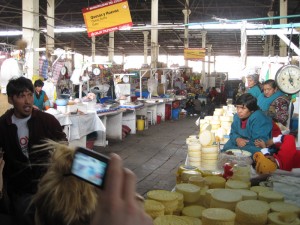
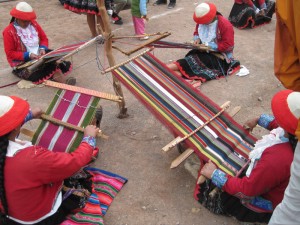
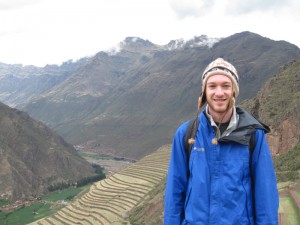
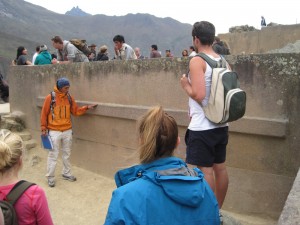
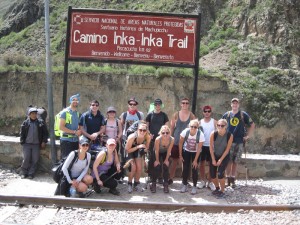
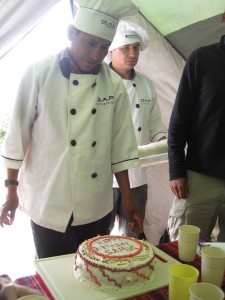

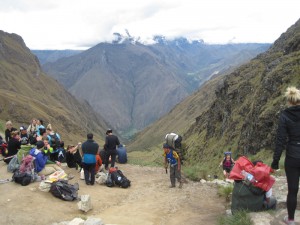
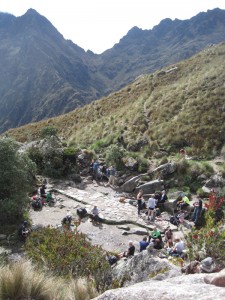

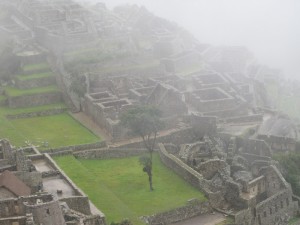

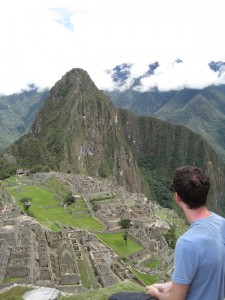
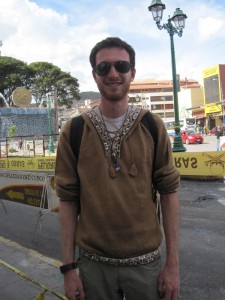
WOW. Just wow.
Amazing Izaak. Now you REALLY have to publish a travel book! :->